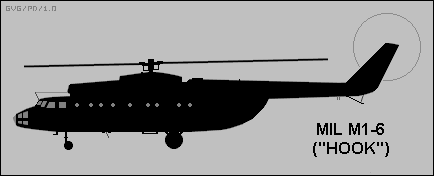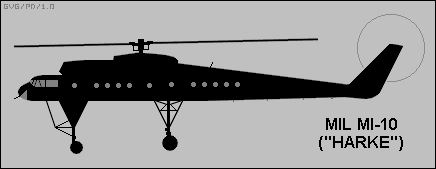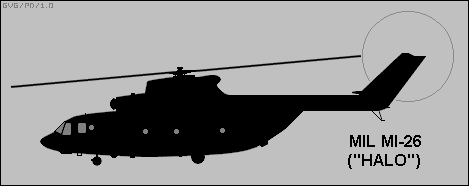Mil Heavy-Lift Helicopters
v1.0.2 / 01 dec 02 / greg goebel / public domain
* The Soviet OKB (experimental design bureau) founded by Mikhail Mil made a specialty of building huge helicopters to carry heavy cargoes. In the new Russia, the Mil organization continues to produce these impressive giants. This document provides a short history of Mil heavy-lift helicopters.

[1] MI-6 ("HOOK")
[2] MI-10 ("HARKE")
[3] MI-12 ("HOMER")
[4] MI-26 ("HALO")
[5] COMMENTS, SOURCES, & REVISION HISTORY
[1] MI-6 ("HOOK")
* The Mil organization began work on their first heavy-lift helicopter in 1954, when the OKB was ordered to design a rotorcraft that could carry a payload of more than 11 tonnes (25,000 pounds) over a distance of 240 kilometers (150 miles). The big rotorcraft was intended for both commercial and military service. Aeroflot wanted to use the machine for operations in trackless backwoods environments, particularly Siberia, and the military wanted it to lift rocket launchers and other heavy weapons.
The result was the huge "Mi-6", which was given the NATO codename "Hook". Five Mi-6 prototypes were produced, the first flying in the fall of 1957 with test pilot Rafail Kaprelian at the controls. The Mi-6 is believed to have entered production in 1960, with about 860 built to end of production in 1981.
The Mi-6 was powered by twin Soloviev D-25V (TB-2BM) turboshaft engines with 4,100 kW (5,500 SHP) each. Access panels to the engines were opened and closed hydraulically, and were sturdy enough to be used as work platforms by maintenance crews. The Mi-6 featured a huge five-bladed main rotor, with metal blades, and a four-bladed tail rotor, with blades made of plastic-impregnated wood built around steel spars. The rotor system was originally fitted with an electrothermal de-icing system, but this was replaced in early production with an alcohol-based scheme.

The Mi-6 featured a crew of five, including pilot, copilot, navigator, radio operator, and flight engineer. It could carry 70 troops on tilt-down seats along the walls, with 20 more seats fitted in the center of the cargo bay. Other possible loads included 41 stretchers and two attendants; an internal cargo load of 11,340 kilograms; or a sling cargo load of almost 8 tonnes (17,500 pounds), with the hoist cable dropped through the cargo bay and out a hatch in the floor.
The rotorcraft had two doors on each side of the cockpit, and the doors could be jettisoned in an emergency. Bulged windows were mounted on the pilot's and copilot's doors to provide visibility down and to the rear. There were also three passenger doors, with two on the left side and one on the right. The Mi-6 had hydraulically-operated rear clamshell doors and a ramp for cargo loading, and the cargo bay had a pulley block system and a winch with a lift capacity of 800 kilograms (1,760 pounds).
Stub wings with a span of 15.3 meters (50 feet 2 inches) were fitted to provide lift in forward flight, with the wings set at an incidence of 15.75 degrees. They were removeable and generally taken off when the machine was used as a flying crane, since when flight speeds were low the wings simply became dead weight.
The Mi-6 normally carried a 75 kW (100 SHP) gas-turbine auxiliary power unit (APU) on a trolley for engine starting and ground power. The rotorcraft had fixed tricycle landing gear, with dual wheels on the nose gear and big single wheels on the main gear. The Mi-6 could be fitted with four auxiliary fuel tanks for ferry flights. Two of these tanks were mounted internally, and two were mounted externally above the main landing gear.
Standard avionics provided day-night, all-weather flight capability. Military variants included an "identification friend or foe (IFF)" transponder and a radar-warning receiver (RWR) system. The Mi-6 could also be fitted with a single DShK 12.7 millimeter machine gun on a flexible mount in the nose. Apparently other weapons fits were evaluated, but it appears that the machine's vulnerability outweighed its ability to carry a heavy load of weapons.
Mi-6s were operated by both Aeroflot and the Soviet military, particularly the Soviet Air Force. The type was exported in small numbers to several Soviet Allies:
- Algeria (at least 4).
- Egypt (probably 12).
- Ethiopia (10).
- Iraq (>15).
- Syria (>10).
- Peru (6).
- North Vietnam (10).
The North Vietnamese used Mi-6s during the Vietnam War to lift jet fighters
from their airfields to remote locations as protection against US air
strikes.
MIL MI-6:
_____________________ _________________ _______________________
spec metric english
_____________________ _________________ _______________________
main rotor diameter 35 meters 114 feet 10 inches
tail rotor diameter 6.3 meters 20 feet 8 inches
footprint length 41.74 meters 137 feet
fuselage length 33.18 meters 108 feet 10 inches
height (tail rotor) 9.86 meters 32 feet 4 inches
height (rotor head) 6.71 meters 22 feet
empty weight 27,240 kilograms 60,050 pounds
max loaded weight 42,500 kilograms 93,700 pounds
maximum speed 300 KPH 185 MPH / 160 KT
service ceiling 4,500 meters 14,800 feet
range 620 kilometers 365 MI / 320 NMI
_____________________ _________________ _______________________
The Mi-6 was produced in a number of variants, many of which remain obscure in the West. Civilian versions included the "Mi-6P", a civilian "airliner" version with square windows and no clamshell doors, as well as a fire-fighting variant. Military variants included the "Mi-6VKP Hook-B", which was fitted as a "command support" helicopter, littered with antennas for communications gear and other equipment; an improved "Mi-22 Hook-C" command support helicopter; and finally a "Mi-6AYaSh Hook-D" command support helicopter.
The Mi-6 was used for troop and equipment airlift, refueling military vehicles in forward areas, forest fire fighting, and recovery of Soyuz space capsules. A dwindling number of weary Mi-6s remained flying in Russia into the 21st century, but in July 2002 one crashed, killing 21 people, and later in 2002 the Russian Ministry of Transport ordered that Mi-6 operations cease. Possibly some may still be flying on occasion in Russia and elsewhere, but for practical purposes that was the end of the Mi-6 story.
[2] MI-10 ("HARKE")
* The Mil bureau designed a "flying crane" version of the Mi-6, designated the "Mi-10 Harke", with the prototype first flown publicly at the Soviet Tushino Air Show in July 1961, and demonstrated at the Paris Air Show in 1965.
The Mi-6 and Mi-10 shared the same engines, transmission, hydraulic system, and rotor system, and the two machines were parts-compatible to a large degree. However, the Mi-10 featured a cut-down fuselage designed mostly for passenger accommodation, and with neither internal clearance nor large loading doors for heavy cargoes. The Mi-10 had large external fuel tanks and wide-track, four-legged, extended landing gear to allow the big helicopter to straddle bulky cargoes.

Interestingly, the right-side gear were 30 centimeters (1 foot) shorter than the left, which caused the Mi-10 to tilt 1.5 degrees to the right when parked. Special wheeled pallets were designed to accommodate payloads for carriage by the Mi-10, with a pallet held in place by hydraulic arms built into the helicopter. As the Mi-10 was designed primarily for the flying-crane role, it was not fitted with stub wings. All four landing gear had dual wheels and shock absorbers.
The Mi-10 had a normal flight crew of three and could accommodate 28
passengers. Early production featured a "dustbin" under the nose to allow
the crew to keep an eye on loads, but later production used a TV camera
instead.
MIL MI-10:
_____________________ _________________ _______________________
spec metric english
_____________________ _________________ _______________________
main rotor diameter 35 meters 114 feet 10 inches
tail rotor diameter 6.3 meters 20 feet 8 inches
footprint length 41.89 meters 137 feet 6 inches
fuselage length 32.86 meters 107 feet 10 inches
height (tail rotor) 9.9 meters 32 feet 6 inches
empty weight 27,000 kilograms 59,525 pounds
normal loaded weight 43,450 kilograms 95,800 pounds
cruise speed, loaded 220 KPH 135 MPH / 120 KT
service ceiling 3,000 meters 9,850 feet
range with tanks 640 kilometers 400 MI / 350 NMI
_____________________ _________________ _______________________
[3] MI-12 ("HOMER")
* Following the Mi-6 and Mi-10, the Mil bureau then developed the biggest helicopter ever built, the "Mi-12 Homer", which was given the Soviet designation of "V-12". It was bigger than a Boeing 727 jetliner, and could carry 120 passengers. In 1969, an Mi-12 carried a payload of over 40 tonnes (36 tons) to an altitude of over 2.25 kilometers (1.4 miles).
Work on the Mi-12 was begun in 1965. Two prototypes were built, with the first flying in 1968 and the type making its public debut at the 1971 Paris Air Show, the year after Mikhail Mil died and was replaced by Professor Marat Tischenko.
The Mi-12 was one of the few modern helicopters that used the side-by-side rotor scheme, with a five-bladed rotor at each wingtip, each rotor powered by two Soloviev D-25VF turboshafts with 4,125 kW (5,500 SHP) each, for a total of four engines. The wings had a "reverse taper", meaning they were wider at the tip than at the root. The engine, transmission, and rotor systems were derived from those of the Mi-6. The side-by-side rotor arrangement allowed these systems to be used with few modifications.
The Mi-12 featured tricycle landing gear, with twin tires on each gear assembly, and clamshell loading doors in the rear. It was flow by six flightcrew.

Development of the Mi-12 proved troublesome, and it became clear that the type would never meet its design specifications. The program was finally cancelled. One prototype remains on static display in Russia.
[4] MI-26 ("HALO")
* One of the reasons that the Mi-12 was cancelled was because Soviet turboshaft engine development had advanced to the point where the requirement for which the oversized helicopter was designed could be met with a less cumbersome machine.
The result was the Mil "Mi-26 Halo", which first flew in December 1977 and went into production in 1981, the same year it was first publicly demonstrated at the Paris Air Show. The Mi-26 formally entered Soviet military service in 1983.
The Mi-26 design was clearly influenced by the Mi-6, with a similar overall configuration and in fact similar dimensions, but modernized and much more capable. The Mi-26 arguably a more elegant machine than the Mi-6, with the lines of a porpoise. It is currently the world's largest production helicopter.

The Mi-26 is only slightly heavier than the Mi-6, but has a much greater cargo capacity of 20 tonnes (44,000 pounds), as compared to 11.8 tonnes (26,000 pounds) for the Mi-6. The Mi-26 is capable of carrying heavy sling loads, and replaced the Mi-10 as well.
The Mi-26 is powered by two Lotarev D-136 turboshaft engines, providing 8,550 kW (11,400 SHP) each. It is fitted with an eight-blade main rotor, with the blades made from fiberglass with steel spar cores and fitted with titanium on the leading edges. The rotor blades have an electrical de-icing system, and the rotor hub is made of titanium. It is the only production helicopter in the world with an eight-blade main rotor, which Mil officials claims gives a very smooth ride, much smoother than the Mi-6.
The tail rotor has five blades, made of fiberglass. The tail is fitted with a fixed horizontal tailplane to help maintain pitch stability. The incidence of the tailplane can be adjusted by ground crews.
The Mi-26 does not have stub wings as fitted on the Mi-6. It has fixed tricycle landing gear, with dual wheels on each gear. The height of the main landing gear can be hydraulically adjusted to assist cargo loading, and sensors are fitted to the landing gear to give the loaded weight of the machine through a cockpit control-panel indicator. The airframe features built-in handholds and footholds to help in field maintenance. The rotorcraft has a built-in APU, fitted under the flight deck, to provide power to systems when on the ground.
The Mi-26 has a standard crew of four, including pilot, copilot, navigator, and flight engineer. The cockpit side windows are bulged to improve visibility. The cockpit does not have its own external crew doors as does the Mi-6. Three TV cameras are fitted to allow observation of loads. The cockpit is pressurized, though the cargo bay is not. There is a four-seat pressurized passenger compartment behind the cockpit.
There are 40 fold-down seats along the cargo bay, and 60 more seats can be
fitted in the center aisle of the cargo bay. There are three passenger
doors, two on the left and one on the right, that open downward and have
built-in steps. The machine has hydraulically-actuated clamshell doors and
a ramp on the end, plus a roller conveyor and two 2.5-tonne (5,500 pound)
capacity electric winches on rails to move payloads around in the cargo bay.
MIL MI-26:
_____________________ _________________ _______________________
spec metric english
_____________________ _________________ _______________________
main rotor diameter 32 meters 105 feet
tail rotor diameter 7.61 meters 25 feet
footprint length 40 meters 131 feet 4 inches
fuselage length 33.73 meters 110 feet 8 inches
height to rotor head 8.145 meters 26 feet 9 inches
empty weight 28,100 kilograms 62,000 pounds
max loaded weight 56,000 kilograms 123,500 pounds
maximum speed 295 KPH 185 MPH / 160 KT
service ceiling 4,600 meters 15,100 feet
range, fully loaded 800 kilometers 500 MI / 435 NMI
_____________________ _________________ _______________________
- Mi-26A: Basic military transport with improved avionics.
- Mi-26T: Basic civil transport, very similar to basic military transport
but lacking military avionics and self-defense kit. This version has
been fitted for firefighting and seismic survey. Some sources mention an
"Mi-26TS", which may be the same rotorcraft but with formal
certification.
- Mi-26MS: Medevac version, apparently available with a number of
different fits, with features such as operating rooms or critical-care
rooms, along with stretcher accommodations.
- Mi-26P: Civilian "airliner" version, with 63 airliner-type seats,
galley, and cloakroom.
- Mi-26TM: Formal flying crane variant, with shallow pilot / observation
gondola under the front fuselage.
- Mi-26TZ: Flying tanker version, with ten hoses for ground vehicles.
There is some information that a command-support variant designated the "Mi-27" was designed, but if so it did not enter service.
At least 200 Mi-26s have been built. The type has been exported to Former Soviet Union nations including Ukraine, Kasakhstan, and Belarus. Ten were sold to India, three were sold to Peru, and the Mexican Air Force has obtained at least two. One Mi-26 was actually rented out by the US military during the Afghanistan campaign of 2001:2002 to pick up a downed Boeing CH-27 Chinook helicopter, with the "Halo" making the Chinook almost seem toylike in comparison.
The Mi-26 remains in production, and some sources mention development of an improved variant, with new rotor blades, more powerful turboshaft engines, and updated avionics.
[5] COMMENTS, SOURCES, & REVISION HISTORY
* One of the interesting footnotes to the Mil heavy-lift helicopters is a design for a "super-heavy" helicopter promoted by the OKB in the early 1980s, designated the "Mi-32". This machine looked like three fat pipes joined together in triangular configuration, with Mi-26 rotor and engine systems at each vertex of the triangle and a cockpit up front. It doesn't appear to have gone beyond the model stage.
* Sources include:
- THE ENCYCLOPEDIA OF MODERN WARPLANES, edited by Bill Gunston, Barnes &
Noble, 1995.
- MODERN FIGHTING HELICOPTERS by Bill Gunston & Mike Spick, Crescent Books,
1996.
- JANE'S ALL THE WORLD AIRCRAFT, 1970 and 1998 editions.
* Revision history:
v1.0 / 01 may 01 / gvg
v1.0.1 / 01 jan 02 / gvg / Minor cosmetic update.
v1.0.2 / 01 jan 02 / gvg / Grounding of Mi-6, minor cosmetic changes.